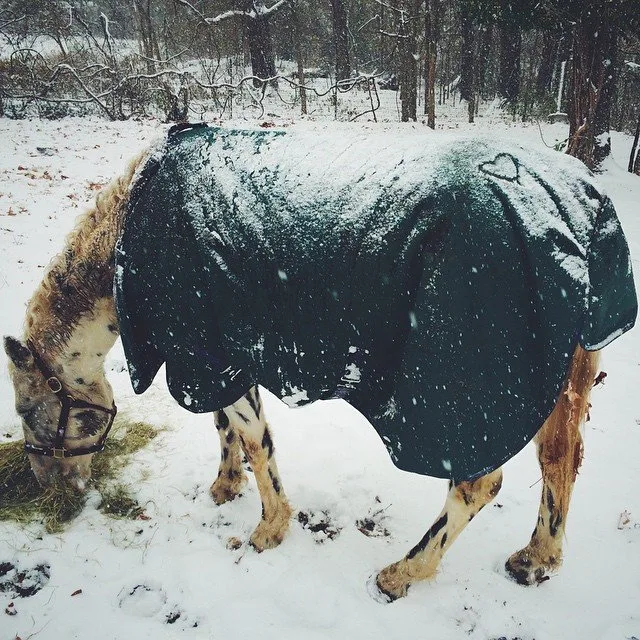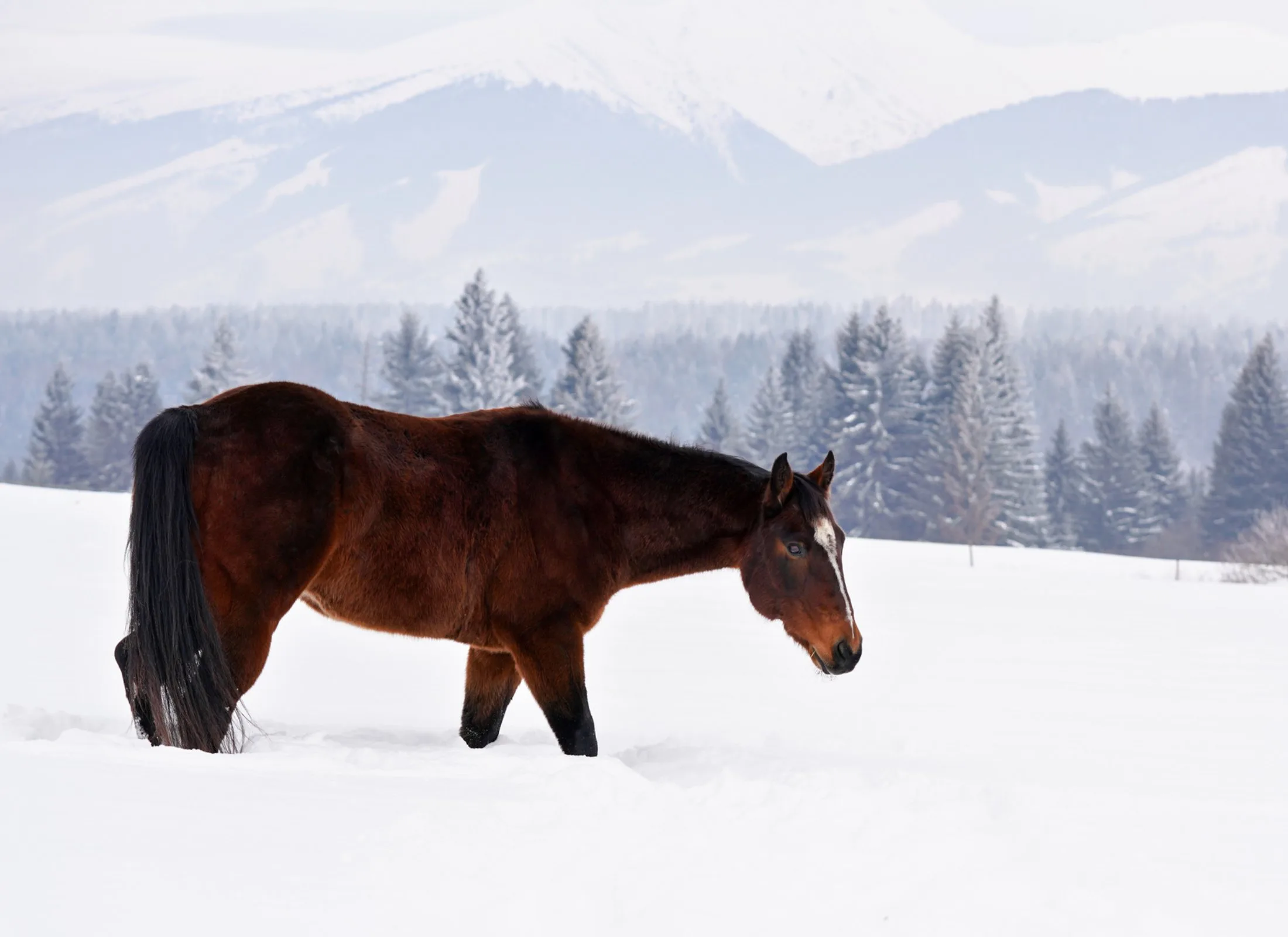Horse blankets are sometimes needed to keep your horse cozy and warm in cold weather. Horses naturally grow a warm, thick coat in the months leading up to winter. While this thick winter fur means most horses stay warm without blanketing, there are a few common reasons that horses should be blanketed.
In this article, you will discover five typical reasons that horses need blankets.
You Clipped Your Horses Hair
If you remove your horse’s thick winter full coat, your horse is susceptible to the cold and needs to be provided extra warmth. You can read more about shedding and a horse’s natural winter coat here.
While clipping your horse is a safe and often encouraged practice, it does mean that you will need to provide a bit of extra care during the colder months.
Horses are clipped for many different reasons. The most common reasons include:
- Keeping horses groom for winter horse shows.
- Managing sweat during intense training in winter months.
- Removing a damaged coat and encouraging a healthy coat to grow next season.
- Reducing the amount of coat maintenance required.
Preventing Excessive Hair Growth
If you compete year-round and don’t want to clip your horse, you may want to consider blanketing your horse. When you blanket your horse as the weather gets colder, your horse’s body can be ‘tricked’ into thinking it is warmer than it actually is and will naturally reduce the amount of hair growth for the winter months.
This method of hair control also reduces the amount of coat maintenance required. It makes competing year-round easier, reduces allergies, and cuts back on the time needed for grooming. Using a blanket to control their hair growth is also beneficial to their health if your horse works hard all year round. Horses that complete hard workouts while they still have their full winter coat easily overheat and become sick.
The downside is that you will need to add extra care for your blanketed horse. Not only do they need to be kept rugged, but you will also need to check them twice a day to ensure the blanket stays in place and does not cause the horse any injury. Click here for our daily chores checklist (I think I saw you had linked a pdf in other articles?)

Your Horse is Getting Older
As your horse ages, its ability to regulate its temperature reduces. They also have a much harder time maintaining their weight and condition. As horses age, their ability to digest fiber decreases up to 5%, and their ability to utilize protein can also reduce by 15%! That means that older horses do not get as much energy from the food they eat, resulting in weight loss and becoming more susceptible to the cold. This inability to stay warm is made worse by any fat loss before winter or any health condition that causes them to use more energy to fight the illness.
If your older horse is in excellent health and has maintained a perfect condition, you may be able to leave them un-blanketed for winter (if the winter is not too harsh). However, if you decide to keep your horse unblanketed, check on them regularly to monitor their weight and condition.
If your older horse starts shivering, they need to be blanketed immediately- but don’t worry about having an extra heavy blanket. Researchers have found evidence that medium-weight blankets seem to work just as well at raising the temperature of horses’ fur.1 Shivering takes a lot of energy and will cause them to lose weight rapidly.
Click here to read more about caring for your horses as they get older
Your Horse is Just Feeling Cold Today
Sometimes you need a blanket just because they are feeling cold. The weather may be more mild than usual, and your horse may have a thick winter coat, but sometimes they still feel cold. Your horse may feel the chill for several reasons. They may have worked up a sweat, and the cold wind is cooling them down. They may not be feeling well, or they may be underweight. Regardless of the reason, if your horse is cold, they should be blanketed as soon as possible.
You can look out for a few signs that mean your horse is probably feeling the cold, including:
- They are shivering
- They are tucking their tail. A tucked tail can be a sign they are trying to warm themselves up
- They feel cold to the touch. You can do a quick temperature test by placing your hand behind your horse’s ears or on their kidneys. The chest and shoulder are also good indicators of their body temperature, but they are not as accurate

Your Horse Usually Lives in a Barn
When horses live indoors, they don’t usually grow a thick coat. When a horse who has been stabled all year goes out to pasture for the day, that short shiny coat leaves them feeling cold and uncomfortable. To combat this issue, you need to give your horse a blanket while outside in the cold weather to ensure they maintain their condition. Once they return to the stable, they should have their blanket removed so that they do not overheat.
About Horse Blankets
Before you read this article, you need to refer to my previous post on horse blankets for beginners. The post is intended for newbies. It details my experience in dealing with horse blankets. Now, let me take this time to tell you how to deal with horse blankets. Just a precaution, you shouldn’t be doing this alone if it’s your first time. Let your trainer demonstrate and observe you until you feel confident.
How To Take off a Horse Blanket
When the horse is securely standing in cross ties or tied quietly, unfasten the surcingles that fasten under the horse’s belly. A typical horse blanket has two surcingles. Unfasten them (usually with a push-twist action) and let them hang.
Then look at his backside (without walking behind the horse) to check if something is wrapped around its tail, or if a strap is fastened between the hind legs (called “leg straps” these straps that pass through the groin help prevent strong winds from blowing a blanket up over the horse’s back)
Then, proceed to the front of the horse and check its chest. You should find buckles that have to be unfastened.
When all buckles are loose, proceed to take off the blanket by sliding it backward and towards you (i.e. don’t drag it straight off the horse’s rear- you might get kicked- but from your position next to the horse pull the blanket off and back).
Stand on your horse’s side, spread your arms, and grab the front of the blanket and the farthest of the back as you can. Then remove the blanket.
As you are lifting the blanket off, you need to slide it in the direction of your horse’s rear. When you’re doing this, ensure that there isn’t anything caught on the horse.
Putting Away Your Horse Blanket
Once removed- don’t throw the blanket on the ground! Instead, fold the blanket, hang it on a rack, or put it where it should be. Most of the time, the horse blankets end up on the floor when they’re removed. If this is how it is in your barn, ensure that it’s propped up safely against a wall. The last thing you want to happen is your horse tripping over your blanket, people stepping on it, or other farm animals making a bed inside.
Final Thoughts on Keeping Your horse Warm
Horses are susceptible to the cold and should be blanketed as soon as they begin o struggle to regulate their temperature. Whether you have clipped your horse, worked them hard, or your horse has lived a life of luxury in a stable, monitoring them to ensure they remain comfy and cozy all year round is essential.
- Hammer, C., & Gunkelman, M. (2020). Effect of different blanket weights on surface temperature of horses in cold climates. Journal of Equine Veterinary Science, 85, 102848. [↩]
